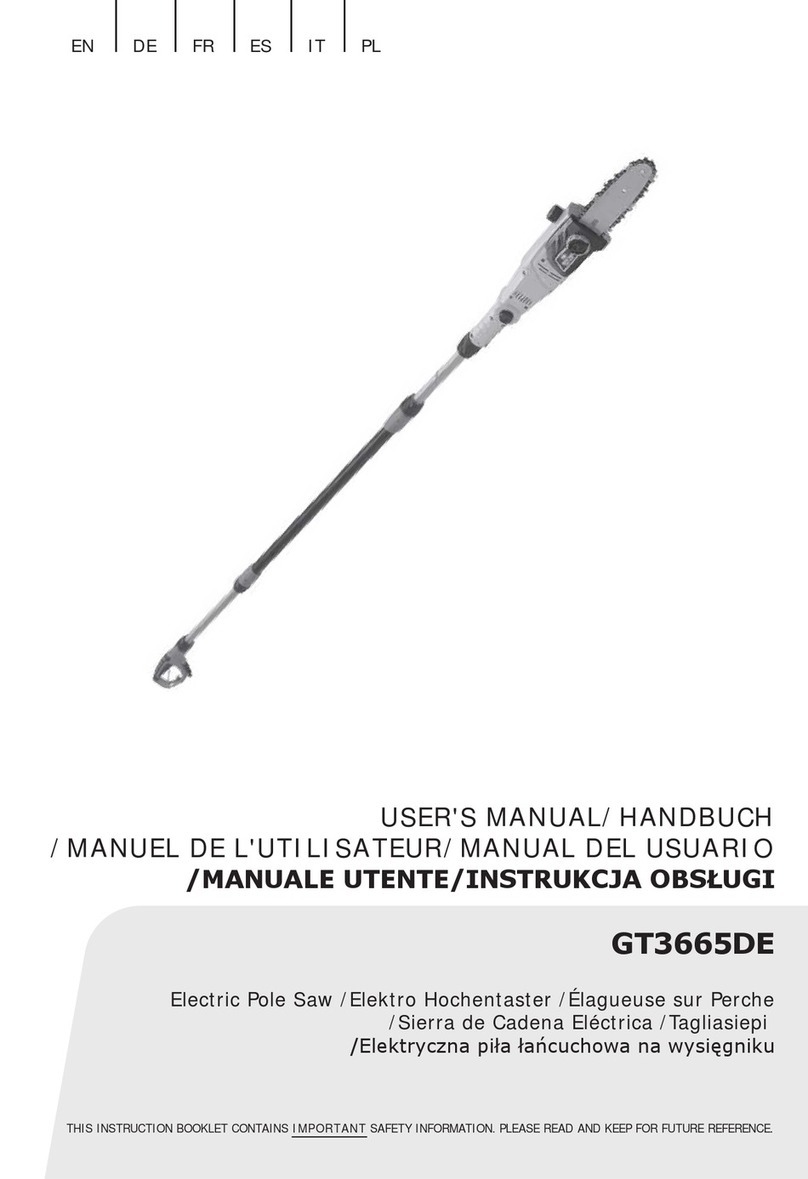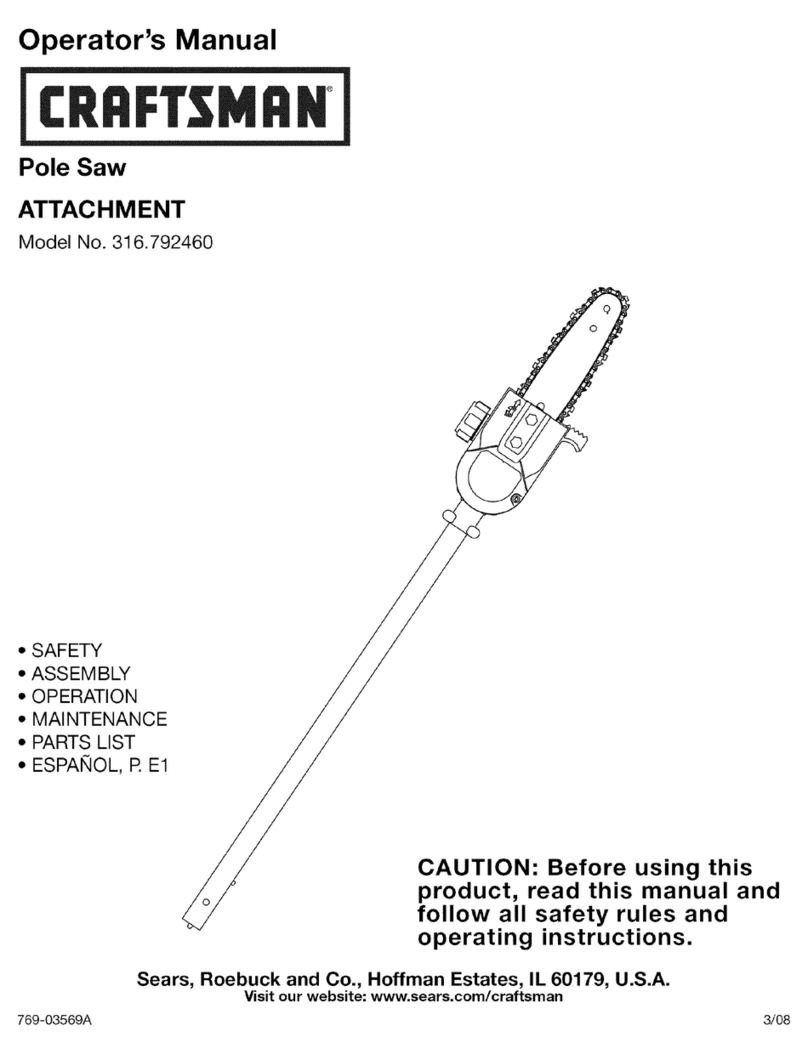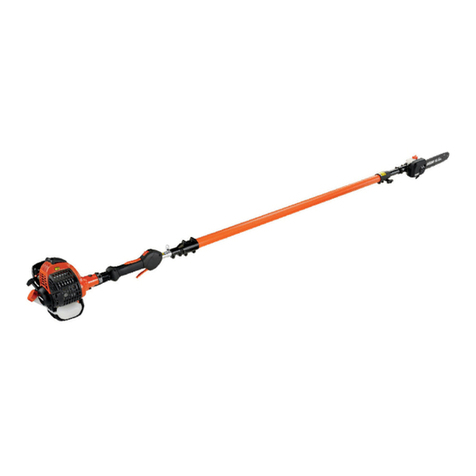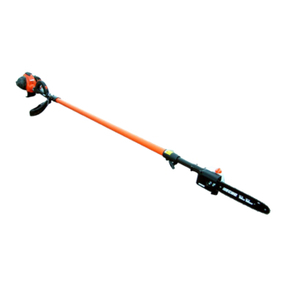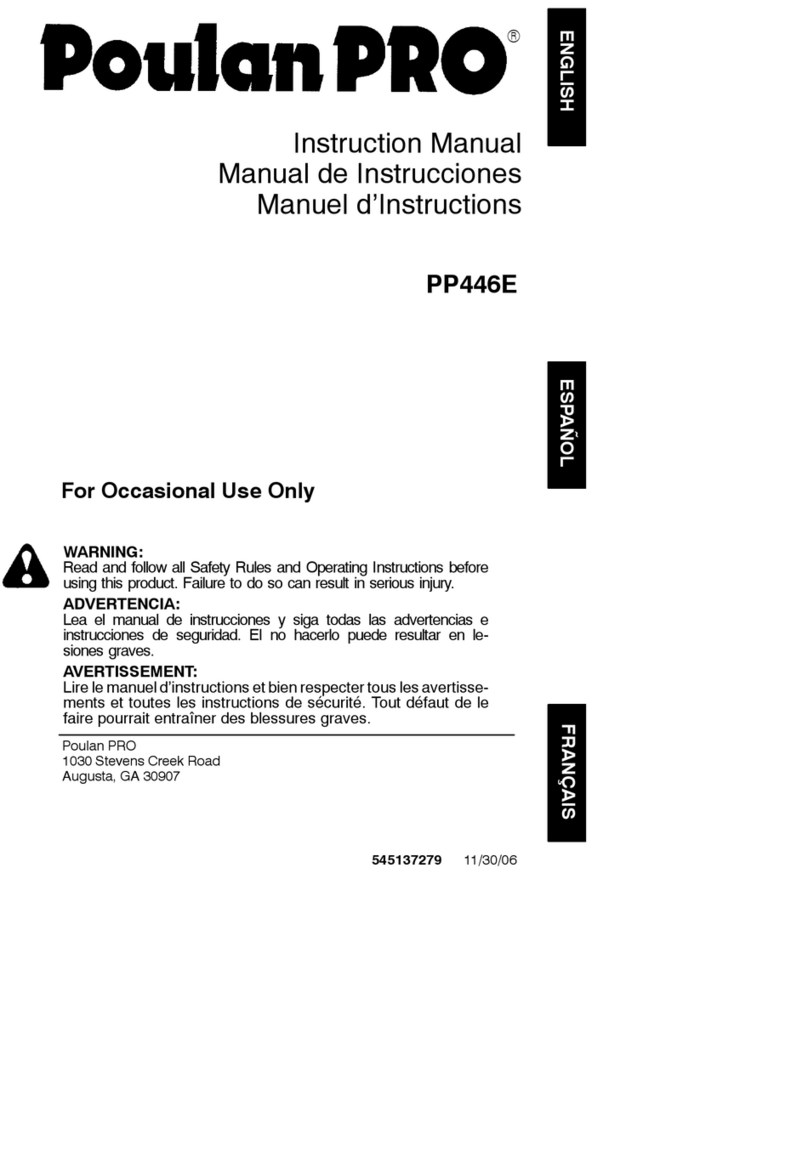Sportsman GPSHT32 User manual

To register your product warranty, please visit buffalotools.com or scan
the QR code.
ITEM # GPSHT32
2-Cycle Gas Powered
Pole Saw w/Hedge Trimmer
Instructions
READ ALL INSTRUCTIONS AND WARNINGS BEFORE USING
THIS PRODUCT.
This manual provides important information on proper operation & maintenance.
Every effort has been made to ensure the accuracy of this manual. These
instructions are not meant to cover every possible condition and situation that may
occur. We reserve the right to change this product at any time without prior notice.
IF THERE IS ANY QUESTION ABOUT A CONDITION
BEING SAFE OR UNSAFE, DO NOT USE THIS
PRODUCT!
QUESTIONS? CONTACT CUSTOMER SERVICE.
Call Customer Service at 1-866-460-9436, Monday-Friday, 8 AM - 4 PM Central
Time. A copy of the sales receipt is required.
KEEP MANUAL, SALES RECEIPT & WARRANTY FOR
FUTURE REFERENCE
5

2
ITEM # GPSHT32 2-Cycle Gas Powered Pole Saw w/Hedge Trimmer
1.
Cutter
bar
2.
Saw chain
3a. Oil tank / cap
3b. Gear unit
4.
Drive rod mechanism
5.
Connecting
piece
6.
Additional
handle
7.
Eyelet
8.
Handle
9. On/Off Switch
10.
Throttle
lock
11.
Throttle
lever
12.
Spark plug boot
13.
Starter
cable
14.
Fuel tank / cap
15. Air filter/housing cover
16.
Choke
lever
17.
Clip
18.
Screw
(4x)
19.
Open-ended
wrench
size
8/10
20.
Hex key
21.
Cutter
guard
22.
Carrying
strap
23.
Oil/Gas
mixing
bottle
24.
Multifunction
tool
25.
Lubrication
nipple
26.
Fuel
pump “primer“
27.
Hedge
trimmer
attachment
28.
Extension
attachment
Items
supplied
•
Open the packaging and take out the
equipment with care.
•
Remove
the
packaging
material
and
any
Important!
The equipment and packaging material are
not toys. Do not let children play with plastic
bags, foils or small parts. There is a danger of
swallowing or suffocating.
•
Original
operating
instructions
The
pole-mounted
2-cycle-powered
trimmer
is
suitable for felling trees or sawing any
materials other than wood. The equipment
may be used only for its intended purpose.
Hedge trimmer (when fitted with reciprocating
blade): The trimmer is intended to be used for
trimming hedges and bushes with diameter not
more than APPROX 1 INCH.
FUEL REQUIREMENTS:
Mix 0.7 oz 2-Cycle Oil with 28 oz Gasoline
Engine type: 2-stroke engine,
air-cooled,
chrome
cylinder
Engine power (max.): 0.85 kW/ 1.14 HP
Displacement: 32.6cc
Engine idle speed:
2700-3400
RPM
Max.
engine
speed:
9,500
RPM
Tank
capacity: 825 cm3
Spark
plug: L7T
Pole saw
Max. cutting length: 9.75”
Chain: 10”, 3/8”, 0.050”
packaging and/or transportation braces (if
available).
Cutter
bar:
Hedge
trimmer
10”, 3/8”, 0.050”
•
Check to see if all items are present.
•
Inspect the equipment and accessories for
transport damage.
•
If possible, keep the packaging until the end
of the guarantee period.
Cutting
length: 14 inches
Cutting
width: approx. 1 inch
Sound
LpA sound pressure level: 114 dB(A)

3
ITEM # GPSHT32 2-Cycle Gas Powered Pole Saw w/Hedge Trimmer
BEFORE USE, FAMILIARIZE YOURSELF WITH AND IDENTIFY THE FOLLOWING :

4
ITEM # GPSHT32 2-Cycle Gas Powered Pole Saw w/Hedge Trimmer
BEGIN ASSEMBLY BY FOLLOWING THE IMAGES, STEP BY STEP.

5
ITEM # GPSHT32 2-Cycle Gas Powered Pole Saw w/Hedge Trimmer

6
ITEM # GPSHT32 2-Cycle Gas Powered Pole Saw w/Hedge Trimmer

7
ITEM # GPSHT32 2-Cycle Gas Powered Pole Saw w/Hedge Trimmer

8
ITEM # GPSHT32 2-Cycle Gas Powered Pole Saw w/Hedge Trimmer

9
ITEM # GPSHT32 2-Cycle Gas Powered Pole Saw w/Hedge Trimmer
Safety
information
Important!
When using the equipment, a few safety
precautions must be observed to avoid injuries
and damage. Please read the complete operating
instructions and safety regulations with due care.
Keep this manual in a safe place, so that the
information is available at all times. If you give the
equipment to any other person, hand over these
operating instructions and safety regulations as
well. We cannot accept any liability for damage
or accidents which arise due to a failure to follow
these instructions and the safety instructions.
For the relevant safety information please refer to
the booklet included in delivery.
Watch out for falling and catapulting
parts.
Read the directions for use before
operating the equipment.
Wear
sturdy,
non-slip
footwear.
Protect the equipment from rain
and damp.
Warning!
Read all the safety information and
instructions.
Any errors made in following the safety
information and the instructions set out below
May result in electric shock or injury. Keep all
safety information and instructions in a safe
place for future use.
Explanation
of
the
symbols
on
the
equipment
Warning!
Wear
protective
headgear,
goggles
And ear muffs.
Electric shock can cause fatal injury.
Keep a distance of at least 32 feet from
power cables.
Direction of the chain movement
and teeth.
Caution: Hot equipment
parts. Keep your distance.
Sound
power
level
guaranteed
Wear
safety
gloves.
114
dB
Switch off the equipment and pull
out. The spark boot plug before
carrying out any maintenance
work.

10
ITEM # GPSHT32 2-Cycle Gas Powered Pole Saw w/Hedge Trimmer
WEAR EAR MUFFS
The noise of impact can cause damage to
hearing.
In operation
Reduce noise generation and vibration to a
minimum!
•
Use only equipment that is in perfect condition.
•
Maintain
and
clean
the
equipment
regularly.
•
Adopt your way of working to the equipment
•
Do not overload the equipment.
Have
the
equipment
checked
if
necessary.
Switch off the equipment when not in use.
•
Wear
gloves.
Important!
Do not start the pole saw until it has been fully
assembled and the chain tension has been
adjusted.
Always wear protective gloves when working
on the pole saw to protect your self against
injury.
Pole Saw
Joining the gear unit to the drive rod
mechanism (Fig. 4-6)
Tools required: Allen keys size 4mm/5mm
(supplied). Push the gear unit (Item 3b) and the
drive rod mechanism (Item 4) into each other.
Center both by turning the screw (Item K).
Important! Make sure that the screw (Item K)
is turned exactly into the guide hole (Item F).
Otherwise there is a risk of the upper part of the
rod mechanism being damaged. To join the two
subassemblies securely together, tighten the
screw (Item I). To take apart, proceed in reverse
order.
Joining the drive rod mechanism to the
connecting piece (Fig. 7-10)
Open the handle screw (Item G) and pull out the
locking pin (H) and hold it clockwise and push
the drive rod mechanism (Item 4) into the
connecting piece (Item 5). Make sure that the
locking pin latches in the guide hole (Item H1)
and tighten the handle screw. To take apart,
undo the handle screw and pull out the locking
pin (H) and hold it clockwise. Pull the drive rod
mechanism out of the connecting piece.
Fitting cutter bar and chain (Fig. 11-16)
Tools
required:
Hex
key
size
5mm
Remove the chain wheel cover (Fig.13/ Item O)
by undoing the fastening screw (Item P). Lay the
chain (Item 2) as shown into the groove which
runs around the cutter bar (Item 1). Note the
alignment of the chain teeth (Fig. 12). Insert the
cutter bar as shown in Fig. 12 into the mount at
the gear unit. Place the chain round the chain
wheel (Item S). Make sure that the teeth of
the chain engage securely in the chain wheel.
The cutter bar must be hooked into the chain
tensioning bolt (Item L).
Fit the chain wheel cover.
Important! Do not fully tighten the fastening
screw until after you have adjusted the chain
tension (see section 5.4).
Tensioning the chain (Fig. 14-16) Important!
Always pull out the spark boot plug before
performing any checks or adjustments. Undo
the fastening screw (Item P) of the chain wheel
cover by a few turns (Fig. 13). Adjust the chain
tension with the chain tensioning screw (Fig.
15/Item M). Turning the screw clockwise
increases the chain tension, turning it
counterclockwise decreases the chain tension.
The chain is correctly tensioned if it can be raised
by around 2 mm in the middle of the cutter bar
(Fig. 14).
Tighten the fixing screw of the chain cover.
(Fig. 16).
Important! Chain links must lie properly in the
guide groove of the cutter bar.
Notes
on
tensioning
the
chain:
The chain must be properly tensioned to ensure
Assembly

11
ITEM # GPSHT32 2-Cycle Gas Powered Pole Saw w/Hedge Trimmer
safe operation. When the saw chain can be raised
by around 2 mm in the middle of the cutter bar,
you know that the chain tension is ideal. During
cutting, the temperature of the chain rises and its
length changes. It is important therefore to check
the chain tension at least every 10 minutes and
to adjust it again as required. This applies in
particular to new saw chains. When you have
finished working, slacken the chain and it
will shorten when it cools down. This will help to
prevent damage to the chain.
Fitting
the
additional
handle
Fit the additional handle as shown in Fig. 17-18.
Hedge
trimmer
Remove the pole saw working head attachment
and attach the hedge trimmer working head.
Please refer the installation procedure (Fig. 7-10).
Swiveling the hedge trimmer (Fig. 31). Press
both lock /release lever (27a) and control lever
(27b) and swivel the hedge trimmer into the
desired position/ angle. Allow the control
lever (27b) to click into the recess in the base
plate (hedge trimmer).
Before
starting
Each time before use, check the following:
•
That there are no leaks in the fuel system.
•
That the equipment is in perfect condition and
that the safety devices and cutting devices
are complete.
•
That all screws are securely fastened.
•
That all moving parts move smoothly.
Fuel and oil
Recommended
fuels
Use only a mixture of unleaded petrol and special
2-stroke engine oil. Mix the fuel mixture as
indicated in the fuel mixing table.
Important: Do not use a fuel mixture which has
been stored for longer than 90 days.
Important: Never use 2-stroke oil with a
recommended mixing ratio of 100:1. The
manufacturer’s warranty will be voided in case of
engine damage due to inadequate lubrication.
Important: Only use containers designed and
approved for the purpose to transport and store
fuel.
Pour the correct quantities of petrol and 2-stroke
oil into the mixing bottle (see scale printed on
the bottle). Then shake the bottle well.
Fuel
mixing
Mix 0.7 oz 2-Cycle Oil
with 28 oz Gasoline (ratio of 40:1)
Chain
lubrication
Important! Never operate the chain if it is not
lubricated with saw chain oil. Use of the pole saw
without saw chain oil or if the oil level is below
the „min“ mark will damage the pole saw.
Important!
Be aware of the temperature conditions:
Different lubricants with completely different
viscosity are required at different ambient
temperatures.
At
lower
temperatures
you
will
need
Low viscosity oils in order to achieve a sufficient
lubricating film. However, if the same low
viscosity oil is used during the summer it will
become even thinner due to the ambient
temperatures alone, and as a result the
lubricating file could break down causing the
chain to overheat and become damaged. In
addition, the chain oil would burn and produce
unnecessary pollutants.
Filling the oil tank (Fig. 1):
Place the pole saw on a flat surface. Clean the
area around the oil tank cap (Fig. 3a) and then
clean the oil tank cap.
Fill the tank (Item 3a) with saw chain oil. In the
process, make sure that no dirt enters the tank,
as this could cause the oil nozzle to become
blocked. Close the oil tank cap.

12
ITEM # GPSHT32 2-Cycle Gas Powered Pole Saw w/Hedge Trimmer
Operation
Starting with a cold engine
Fill the tank with the required amount of oil/ gas mix.
Set the equipment down on a hard surface.
1.
Press the fuel pump (primer) (Fig. 2/Item 26) 10 times.
3. Move the on/off switch to ON “I”
4. Set the choke lever (Fig. 2/Item 16) to “START”.
5. Hold the equipment firmly and pull out the
starter cable (Fig. 2/Item 13) until you feel it begin to resist. Then tug sharply on the starter cable 4 times.
The equipment should start.
Once the engine has started, move the choke lever immediately to “RUN“ and allow the equipment to
warm up for approx. 10 seconds. Important: Since the throttle lever is secured, the cutting tool starts to
operate when the engine is started.
Then release the throttle lever by actuating it once.
6. If the engine does not start up, repeat steps 4-6 above.
Please note: If the engine does not start up even after several attempts, read the section “Engine
troubleshooting“.
Starting
with
a
warm
engine
(The equipment has been idle for less than 15-20min.)
1. Set the equipment down on a hard, level surface.
Switch the On/ Off switch to “I”.
Secure the throttle lever (in the same way
as described in “Starting with a cold
engine“).
Hold the equipment and pull out firmly the
starter cable until you feel it start to
resist. Then tug sharply on the starter
cable. The equipment should start after
1-2 tugs. If the equipment does not start
after 6 pulls, repeat steps 1 - 7 for starting
the engine from cold.
Troubleshooting engine restart
Please follow these Instructions to
restart the machine.
Check either the fuel pipe aging or
cracking, if any, easy to buy new
one for replacement at local
store.
Check either the fuel pipe joint of
carburetor loosening or aging, if any,
cut the pipe joint a little bit to rejoin as
well.
Please pull the starting rope 5-8 times
Before fuel refilling to the carburetor is in an
operating
state.
Refill the fuel and restart the
machine according to the cold start mode.
Emergency Stop procedure:
If it becomes necessary to stop the equipment
immediately, set the On/ O switch to”Stop” or” O”.
Normal
procedure:
Let go of the throttle lever and wait until the
engine has changed to idling speed. Then set the
On/Off switch to ”Stop” or ”O”.
Fitting
the
shoulder
strap
Important!
Always
use
the
shoulder
strap
when
Working with the equipment. Switch o the
equipment before you take off the shoulder strap
(risk of injury).
1.
Slip the shoulder strap over your shoulder.
2.
Adjust the length of the shoulder strap so that
the strap attachment is at waist level.
Practice
Practice all the work steps with the engine switched
off before you start to use the equipment.

13
ITEM # GPSHT32 2-Cycle Gas Powered Pole Saw w/Hedge Trimmer
USE INSTRUCTIONS
Working with the pole saw
Preparations
To ensure that you can work safely, check the
following
points
before
every
use:
Condition
of
the
pole
saw
Before you start your work, inspect the pole saw
for damage to the housing, the chain and
the cutter bar. Never use a pole saw which is
obviously damaged.
Oil
container
Level of oil in the oil container: Both before and
during your work make sure that there is always
Sufficient oil in the system. To avoid damaging
the pole saw, never run the saw if there is no oil
in the system or if the oil drops below the “min“
mark.
On average, a single filling will last 10
minutes depending on the number of pauses in
cutting and the loads involved.
Chain
Tension of the chain, condition of the cutting
elements: The sharper the chain, the easier and
more controllable it is to operate the pole saw.
The same also applies to the chain tension. For
greater safety you must check the chain tension
before your work and at least every 10 minutes
during your work. New chains in particular tend
to expand more.
Safety
clothing
Always wear appropriate tight-fitting safety
clothing such as special trousers which protect
against cuts, protective gloves and safety shoes.
Hearing
protection
and
protective
goggles
Wear a protective helmet with integral face and
hearing protection. This will offer protection
against
falling
branches
and
recoiling
branches.
Safe working
Never stand under the branch you want to saw.
Use special caution when working with branches
under tension and splintering wood.
Possible risk of injury caused by falling branches
and catapulting pieces of wood.
When the equipment is in operation, keep other
persons and animals away from the danger zone.
The equipment is not protected from electric
shock through contact with high-voltage cables.
Keep a minimum distance of 10 m from live
cables. Electric shock can cause fatal injury.
When working on slopes always stand to the
upper or left or right side of the branch you want
to cut.
Hold the equipment as close as possible to your
body. This will help you to keep your balance.
Cutting
techniques
Start with the bottom branches on the tree. This
will make it easier for the cut branches to drop.
After completing a cut, the weight of the saw will
abruptly increase for the operator as the saw
is no longer supported by the branch. This can
result in you losing control over the saw.
Remove the saw from the cut only with the saw
chain still running. This will prevent the saw from
getting jammed.
Never cut with the tip of the saw.
Never cut into the bulging branch collar. This will
prevent the tree from healing.
Sawing off smaller branches (Fig.23):
Place the contact surface of the saw onto the
branch. This will prevent the saw from making
jerky movements when you begin a cut. Exerting
slight pressure, guide the saw from the top to the
bottom through the branch.
Sawing off large and long branches (Fig.24):
Carry out a relief cut when working on large
branches.
Start by sawing through 1/3 of the branch
diameter (a) from the top to the bottom with the
top side of the cutter bar. Then saw towards
the first cut (b) from the top to the bottom with
the bottom side of the cutter bar. Saw off
long branches in several steps to keep control
over the impact location.

14
ITEM # GPSHT32 2-Cycle Gas Powered Pole Saw w/Hedge Trimmer
Maintenance
Kickback
The term “kickback“ describes what happens
when the running pole saw suddenly kicks
upward and backward. Usually this is caused by
contact between the tip of the cutter bar and the
work piece or by the saw chain becoming
trapped.
In the event of kickback, large forces occur
suddenly and violently. As a result, the pole saw
usually reacts uncontrollably. This can often result
in very serious injuries to the worker or persons in
the vicinity. The risk of kickback is at its greatest
when the saw is positioned for a cut in the region
of the tip of the cutter bar, as the leverage effect
is greatest there. It is therefore safest to position
the saw as flat as possible.
Important!
•
Make sure that the chain tension is always
correctly adjusted.
•
Only use a pole saw if it is in perfect working
order.
•
Only work with a saw chain that has been
properly sharpened in accordance with the
instructions.
•
Never cut with the upper edge or the tip of the
cutter
bar.
Always hold the chainsaw firmly with both
hands.
Cutting wood which is under tension
Special care is required when cutting wood which
is under tension. Cutting wood which is under
tension can release the tension, causing the
wood to react out of control. In the worst case
this can result in severe and even fatal injuries.
This type of work must be performed only by
specially trained persons.
Working with the hedge trimmer
Cutting techniques (Fig32)
The
double-sided
cutter
bar
allows
cutting
in
both directions or by using swinging movements
from one side to the other.
For a vertical cut, move the hedge trimmer
evenly forwards or up and down in an arc.
For a horizontal cut, move the hedge trimmer
in a scything motion along the edge of the hedge
so that cut branches fall to the ground.
NOTE
Remove
thicker
branches
with
a
branch
cutter.
Replacing
the
chain
and
cutter
bar
The cutter bar needs to be replaced if the guide
groove of the cutter bar is worn.
Proceed as described in the section„Fitting
the cutter bar and the chain“.
Checking the automatic chain lubrication
You should check the operation of the
automatic chain lubrication system on a
regular basis in order to guard against
overheating and the damage this can cause to
the cutter bar and the chain.
Point the tip of the cutter bar at a smooth surface
(a board or a cut tree face) and allow the
pole saw to run. If you see a growing oil stain
on the smooth surface, the automatic chain
lubrication system is working properly. If
there is no clear oil stain, please refer to the
corresponding instructions in the section
“Troubleshooting“. If the information
contained there still fails to remedy the
situation,
please
contact
customer service
Important! Do not actually touch the surface with
the tip of the cutter bar when performing this
test. Keep a safe distance (approx. 8”).

15
ITEM # GPSHT32 2-Cycle Gas Powered Pole Saw w/Hedge Trimmer
Cleaning,
storage,
transpor
t
Sharpening
the
chain
The chain can be re-sharpened by any dealer. Do
not attempt to sharpen the chain yourself unless
you have the necessary special tools and
experience.
Air Filter Maintenance (Fig 25-27)
Maintenance of the air filter (Fig 25-27) Soiled air
filters reduce the engine power by supplying too
little air to the carburetor. Regular checks are
therefore essential. The air filter should be checked
after every 25 hours of use and cleaned if necessary.
If the air contains a lot of dust, the air filter should
be checked frequently.
1. Remove the air filter cover (Fig 25-26)
2. Remove the air filter (Fig 27)
3. Clean the air filter by tapping it or blowing it
out.
4. Assemble
in
reverse
order.
Maintenance of the spark plug (Fig. 27) Spark
plug sparking gap = 0.6mm. Tighten the spark
plug with a torque of 12 to 15 Nm. Check the
spark plug for dirt and grime after 10 hours of
operation and if necessary clean it with a copper
wire brush. Thereafter service the spark plug after
every 50 hours of operation.
1.
Pull out the spark boot plug (Fig. 28).
2.
Remove the spark plug (Fig. 28) with the
supplied multifunction tool (Item 24).
3.
Assemble
in
reverse
order.
Applying
grease
to
the
gear
unit
After every 20 hours of use add a little gear
grease (approx. 10 g.) at the lubrication nipple
(Fig. 4/Item 25).
Cleaning
•
Regularly clean the tensioning mechanism
by blowing it out with compressed air or
cleaning it with a brush. Do not use any tools
for cleaning.
•
Keep the handles free of oil so that you can
maintain a firm grip.
•
Clean the equipment as required with a damp
cloth and, if necessary, mild washing up
liquid.
•
If you are not going to use the pole saw for an
extended
period
of
time,
remove
the
chain
oil
from the tank. Briefly immerse the saw chain
and the cutter bar into an oil bath and then
wrap them in oil paper.
Important!
Always pull out the spark boot plug each time
before carrying out any cleaning. Never immerse
the equipment in water or other liquids in order
to clean it.
Store the pole saw in a safe and dry place out of
the reach of children.
Storage
Important: Never put the equipment into storage
for longer than 30 days without carrying out the
following steps.
Storing
the
equipment
If you intend to store the equipment for longer
than 30 days, the equipment must be prepared
accordingly. Otherwise the fuel still remaining in
the carburetor will evaporate and leave a rubbery
sediment. This can cause problems when starting
up the equipment and may require expensive
repairs.
1.
Slowly remove the fuel tank cap to release
any pressure that may have formed in the
tank. Carefully empty the tank.
2.
To remove the fuel from the carburetor, start
the engine and let it run until the equipment
stops.
3.
Leave the engine to cool (approx. 5 minutes).
4.
Remove the spark plug (see section 9.5).
5.
Add one teaspoon of 2-stroke engine oil into
the combustion chamber. Slowly pull the starter
cord several times to apply a layer of oil
to all internal components. Fit the spark plug
again.

16
ITEM # GPSHT32 2-Cycle Gas Powered Pole Saw w/Hedge Trimmer
TROUBLESHOOTING
Fault
Possible
cause
Remedy
The equipment
does not start.
-
Correct starting procedure not
followed
-
Dirty or damp spark plug
-
Incorrect
carburetor
setting
-
Follow
the
instructions
for
starting
-
Clean the spark plug or replace it
with a new one
-
Contact customer service.
The equipment
starts but does
not develop its full
power.
-
Incorrect
choke
lever
setting
-
Incorrect
carburetor
setting
-
Set the choke lever to “ON”.
Clean the air filter
-
Contact customer service.
The engine does
not run smoothly.
-
Incorrect electrode gap on the
spark plug
-
Incorrect
carburetor
setting
-
Clean the spark plug and adjust the
Electrode gap, or fit a new spark
plug
-
Contact an authorized customer
service.
Engine smokes
excessively.
-
Incorrect
fuel
mix
-
Incorrect
carburetor
setting
-
Use the correct fuel mix (see fuel
mixing table)
-
Contact an authorized customer
service.
Saw chain is dry.
-
No oil in the tank
-
Vent in the oil tank cap is blocked
-
Oil outlet blocked
-
Top up with oil
-
Clean the oil tank cap
-
Clear the oil outlet
Chain/guide bar
is hot.
-
No oil in the tank
-
Vent in the oil tank cap is blocked
-
Oil outlet is blocked
-
Chain is blunt
-
Chain is over-tensioned
-
Top up with oil
-
Clean the oil tank cap
-
Clear the oil outlet
-
Re-sharpen
or
replace
the
chain
-
Check the chain tension
Pole saw judders,
vibrates or does not
saw properly.
-
Chain is under-tensioned
-
Chain is blunt
-
Chain is worn
-
Saw teeth point in the wrong
direction
-
Adjust the chain tension
-
Re-sharpen
or
replace
the
chain
-
Replace
the
chain
Refit the chain with the teeth facing
in the correct direction

17
ITEM # GPSHT32 2-Cycle Gas Powered Pole Saw w/Hedge Trimmer

18
ITEM # GPSHT32 2-Cycle Gas Powered Pole Saw w/Hedge Trimmer

19
ITEM # GPSHT32 2-Cycle Gas Powered Pole Saw w/Hedge Trimmer

20
ITEM # GPSHT32 2-Cycle Gas Powered Pole Saw w/Hedge Trimmer
Table of contents
Popular Pole Saw manuals by other brands

Briggs & Stratton
Briggs & Stratton 1696893 Operator's manual

Makita
Makita UA003G instruction manual
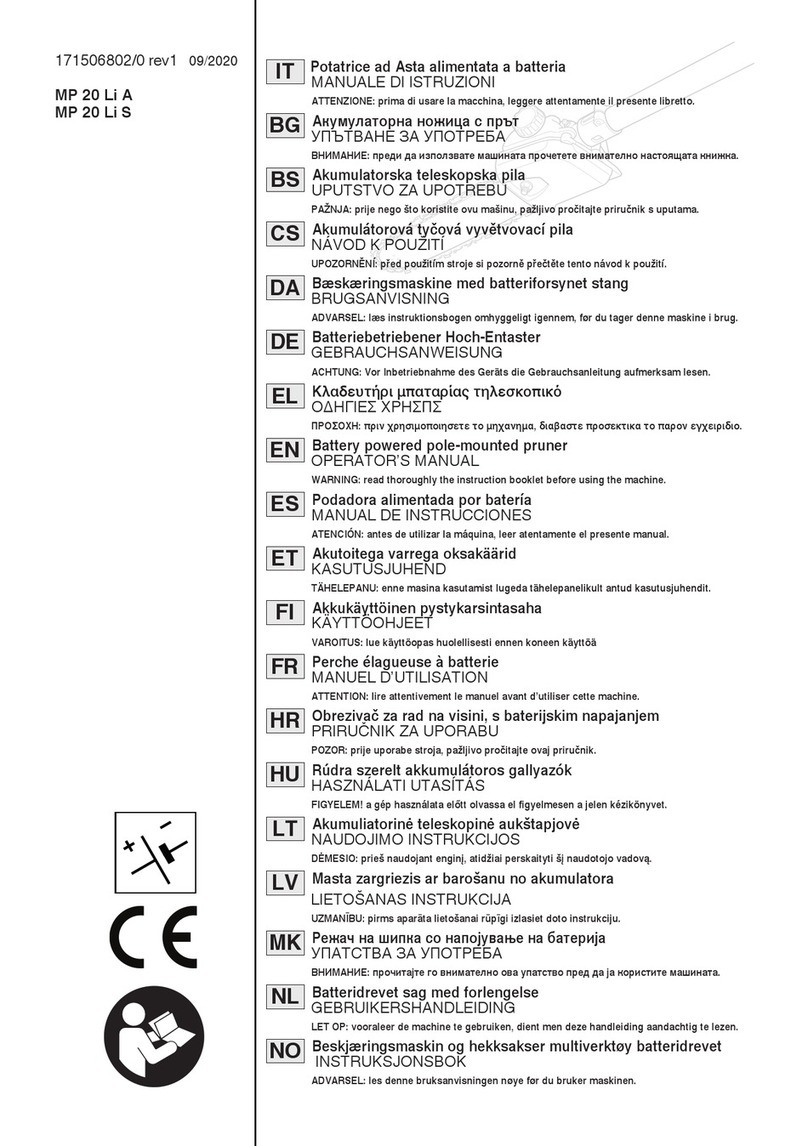
Stiga
Stiga MP 20 Li A Operator's manual
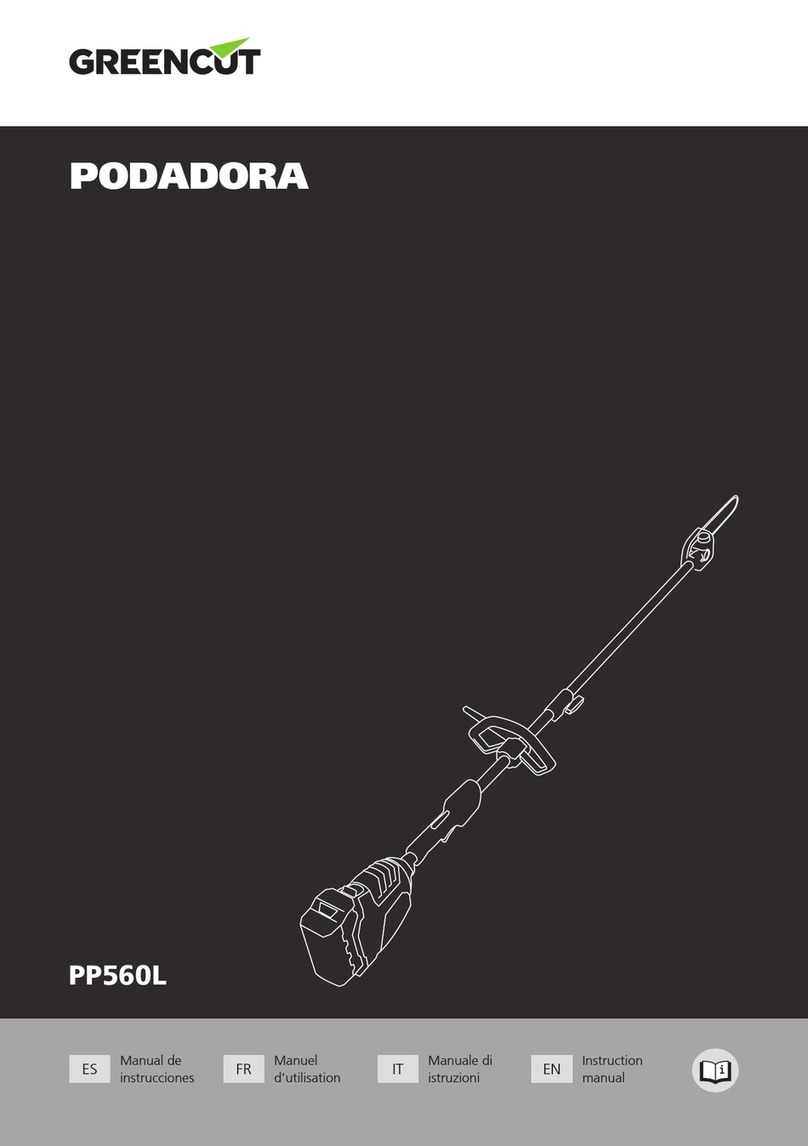
Greencut
Greencut PP560L instruction manual

Black & Decker
Black & Decker GPC1800 instruction manual

Greenlee
Greenlee LHFS-210001 Operation, service and parts instruction manual
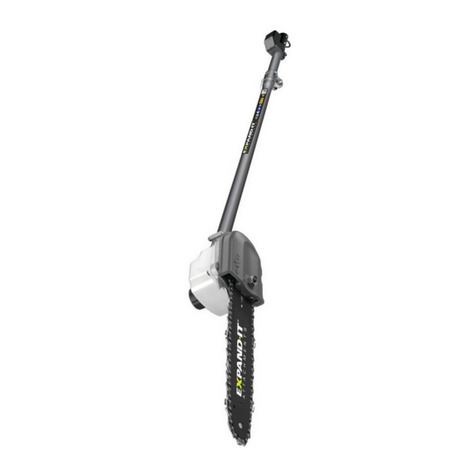
Expand-it
Expand-it APR-03 user manual

Germania
Germania AKS 71 TELE Translation of the original instructions

Parkside
Parkside PAHE 20-Li C3 Translation of the original instructions
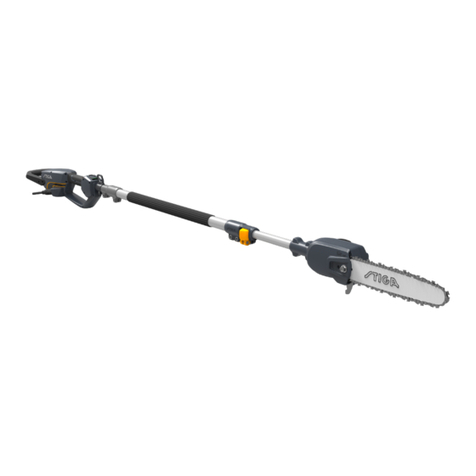
ST. SpA
ST. SpA MP 900 Li 48 Operator's manual

Makita
Makita DUC101Z01 instruction manual

ATIKA
ATIKA KSH 710 SDS Original instructions
